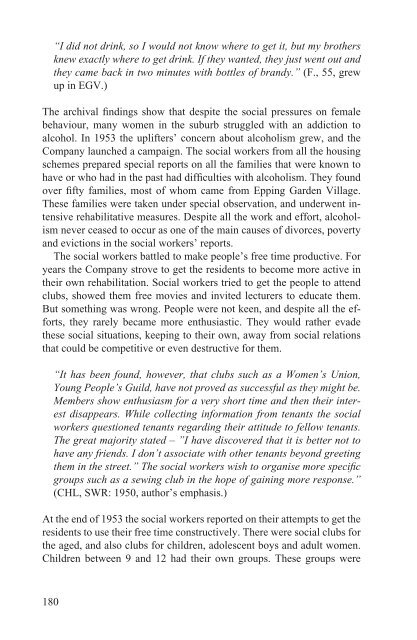The Making of a Good White - E-thesis - Helsinki.fi
The Making of a Good White - E-thesis - Helsinki.fi
The Making of a Good White - E-thesis - Helsinki.fi
Create successful ePaper yourself
Turn your PDF publications into a flip-book with our unique Google optimized e-Paper software.
“I did not drink, so I would not know where to get it, but my brothers<br />
knew exactly where to get drink. If they wanted, they just went out and<br />
they came back in two minutes with bottles <strong>of</strong> brandy.” (F., 55, grew<br />
up in EGV.)<br />
<strong>The</strong> archival <strong>fi</strong>ndings show that despite the social pressures on female<br />
behaviour, many women in the suburb struggled with an addiction to<br />
alcohol. In 1953 the uplifters’ concern about alcoholism grew, and the<br />
Company launched a campaign. <strong>The</strong> social workers from all the housing<br />
schemes prepared special reports on all the families that were known to<br />
have or who had in the past had dif<strong>fi</strong>culties with alcoholism. <strong>The</strong>y found<br />
over <strong>fi</strong>fty families, most <strong>of</strong> whom came from Epping Garden Village.<br />
<strong>The</strong>se families were taken under special observation, and underwent intensive<br />
rehabilitative measures. Despite all the work and effort, alcoholism<br />
never ceased to occur as one <strong>of</strong> the main causes <strong>of</strong> divorces, poverty<br />
and evictions in the social workers’ reports.<br />
<strong>The</strong> social workers battled to make people’s free time productive. For<br />
years the Company strove to get the residents to become more active in<br />
their own rehabilitation. Social workers tried to get the people to attend<br />
clubs, showed them free movies and invited lecturers to educate them.<br />
But something was wrong. People were not keen, and despite all the efforts,<br />
they rarely became more enthusiastic. <strong>The</strong>y would rather evade<br />
these social situations, keeping to their own, away from social relations<br />
that could be competitive or even destructive for them.<br />
“It has been found, however, that clubs such as a Women’s Union,<br />
Young People’s Guild, have not proved as successful as they might be.<br />
Members show enthusiasm for a very short time and then their interest<br />
disappears. While collecting information from tenants the social<br />
workers questioned tenants regarding their attitude to fellow tenants.<br />
<strong>The</strong> great majority stated – ”I have discovered that it is better not to<br />
have any friends. I don’t associate with other tenants beyond greeting<br />
them in the street.” <strong>The</strong> social workers wish to organise more speci<strong>fi</strong> c<br />
groups such as a sewing club in the hope <strong>of</strong> gaining more response.”<br />
(CHL, SWR: 1950, author’s emphasis.)<br />
At the end <strong>of</strong> 1953 the social workers reported on their attempts to get the<br />
residents to use their free time constructively. <strong>The</strong>re were social clubs for<br />
the aged, and also clubs for children, adolescent boys and adult women.<br />
Children between 9 and 12 had their own groups. <strong>The</strong>se groups were<br />
180
















